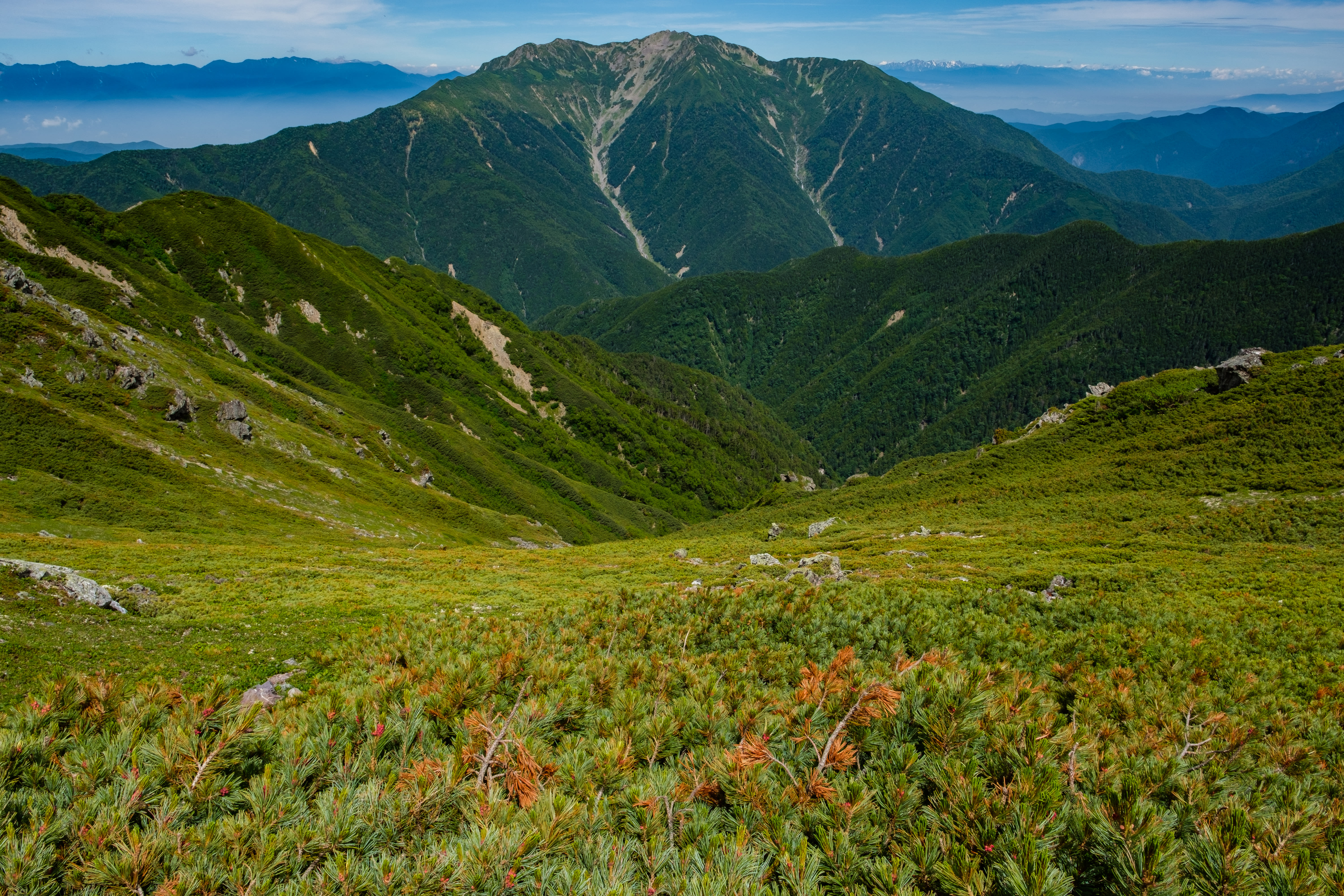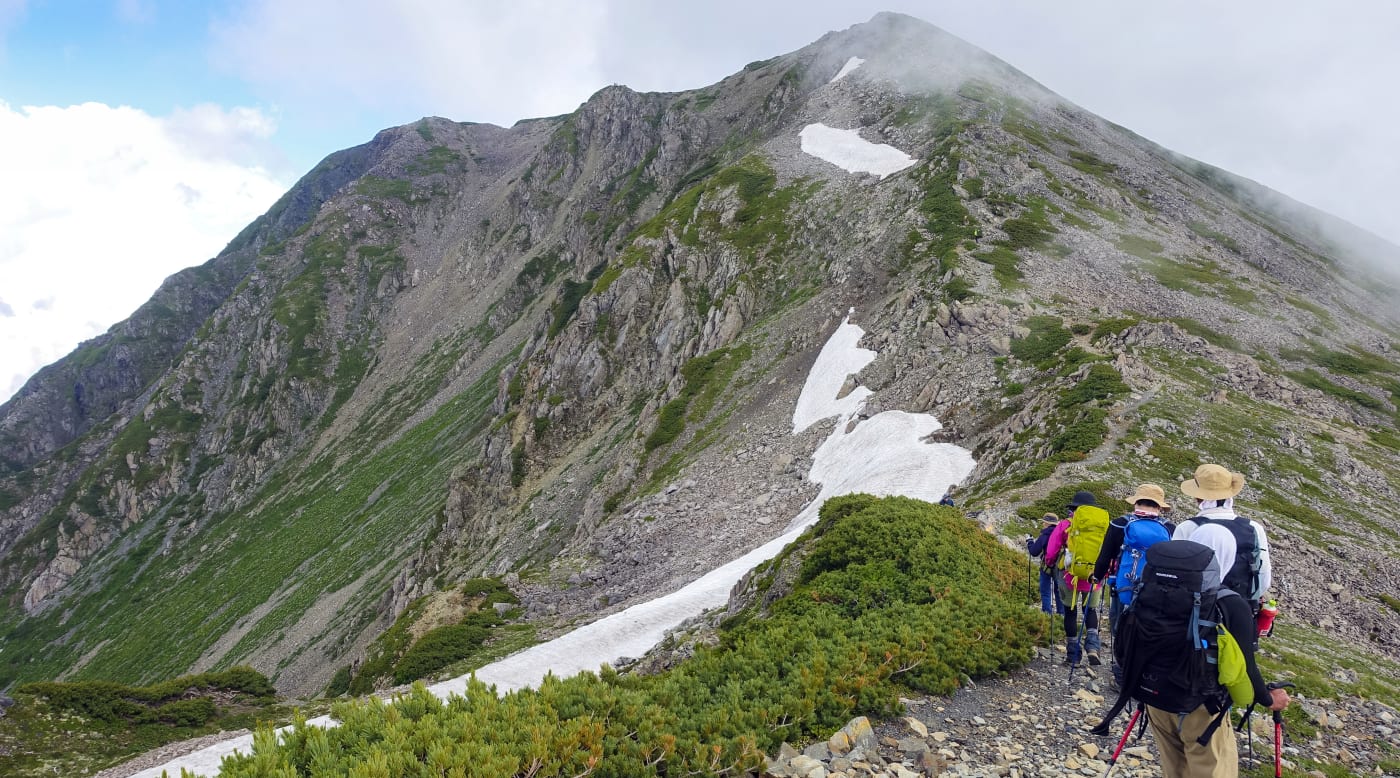Mount Kitadake Area
Minami Alps National Park has several mountains over 3,000 meters high. The tallest is Mount Kitadake (3,193 m), Japan’s second-highest peak after Mount Fuji (3,776 m). The mountain is part of a range called Shirane Sanzan—meaning “Three White Peaks”—along with Mount Ainodake and Mount Notoridake.
In the foothills you can walk through stands of Erman’s birch trees. Higher up, Japanese beech trees give way to coniferous forest. Near Mount Kitadake’s summit you may spot Kitadake-so (Callianthemum hondoense)—an indigenous type of herb that blooms at the end of June—and eightpetal mountain-avens, a relict species from the ice age. Other rare alpine blooms also grow here.
Ascending this peak takes several hours, but if you need a break there are mountain huts along the way. While you’re climbing, keep an eye out for rock ptarmigan—a type of grouse protected in Japan.
From the summit you can enjoy views of the Houou Sanzan mountains across the valley. The granite-tipped mountain ridge has three peaks—Mount Jizodake, Mount Kannondake and Mount Yakushidake. They are all around 2,800 meters high.
To the east is Mount Senjogatake, known as the Queen of the Minami Alps for its comparatively gentle slopes and rounded peaks. The mountain is popular with hikers, but at 3,033 meters it is still a challenging hike. There are several mountain huts and rest stops along the trail from Odaira Villa in the northern foothills. You may spot the elusive Japanese stoat—a type of ermine— among the rocks as well as rock ptarmigan.
You can get more information about hiking Mount Kitadake and the surrounding peaks at the Norogawa-Hirogawara Information Center.
Mount Shiomidake Area
Another popular mountain with climbers is Mount Shiomidake (3,047 m), an unusual dome-shaped mountain at the park’s heart with two peaks. The trail to the summit starts from the Torikura Forest Road.
South of here lies the Arakawa Sanzan mountain range, which includes Mount Higashidake (also known as Mount Warusawadake), Mount Nakadake and Mount Maedake. Hike these peaks to discover some of the most southerly glacial landforms in Japan, including several impressive cirques alongside alpine meadows.
Akaishi Mountains
The Akaishi mountain range runs from Mount Akaishi to Mount Tekari at the southern limits of the park. You can see where the rivers have cut deep V-shaped valleys through mountainsides covered with dense forests of dwarf pines.
From the Minami Alps Shizen Fureai Center, you can take any one of several hiking trails heading up the mountain range.
Between Mount Kamikochi and Mount Chausudake, you can explore an area where unusual periglacial activity caused the ground to constantly freeze and thaw. That activity aligned stones here in geometric shapes—often in hexagonal formations—to create the phenomenon known as patterned ground.
Culture
Mountains are at the heart of local traditions and rituals in this region, and you’ll find numerous small shrines devoted to the spirits and gods of the land. In the foothills of Mount Kai-Komagatake is Kai-Komagatake Shrine, the spiritual home of the region since the 1800s. Twice a year processions of climbers dressed in white paying respects to the mountain's god before climbing from Kuroto-one to Kai-Komagatake.
On Mount Jizodake you can find another sacred place adorned with statues and figurines. Legend has it that couples wishing to have a child should take one of the statues home. If their prayers come true, they must return the statue to the same spot and leave an extra one.





















